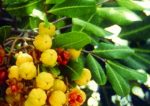 Carrotwood, also known as tuckeroo and beach tamarind, is a slender evergreen tree native to coastal areas and wetlands of Australia, Indonesia, and New Guinea. It is commonly used as a street tree especially in coastal areas of California but has become a problem in southern Florida where it has invaded spoil islands, beach dunes, marshes, tropical hammocks, pinelands, mangrove and cypress swamps, scrub habitats, and coastal strands. Plants have a single trunk with rough grey outer bark and orange inner bar. The compound leaves are yellow-green and glossy, and have four to twelve leaflets two to eight inches long. Separate small white to yellow male and female flowers appear on the same tree in winter and female flowers give way to capsules ¼-1” in diameter. The capsules are orange to yellow when ripe in the summer and contain three black seeds. Fruit is attractive to birds but can cause litter problems. Plant prefer full sun and wet to moist soil, but tolerate drought and salt. USDA Hardiness Zones 10-11
Carrotwood, also known as tuckeroo and beach tamarind, is a slender evergreen tree native to coastal areas and wetlands of Australia, Indonesia, and New Guinea. It is commonly used as a street tree especially in coastal areas of California but has become a problem in southern Florida where it has invaded spoil islands, beach dunes, marshes, tropical hammocks, pinelands, mangrove and cypress swamps, scrub habitats, and coastal strands. Plants have a single trunk with rough grey outer bark and orange inner bar. The compound leaves are yellow-green and glossy, and have four to twelve leaflets two to eight inches long. Separate small white to yellow male and female flowers appear on the same tree in winter and female flowers give way to capsules ¼-1” in diameter. The capsules are orange to yellow when ripe in the summer and contain three black seeds. Fruit is attractive to birds but can cause litter problems. Plant prefer full sun and wet to moist soil, but tolerate drought and salt. USDA Hardiness Zones 10-11
The following native plants are recommended alternatives:
Gumbo Limbo (Bursera simaruba)
A small to medium sized tree, gumbo limbo is native to tropical regions of the Americas from southern Florida to Mexico, the Caribbean, and northern parts of South America. Its red exfoliating bark is very attractive and it tolerance of salt and winds make it a good choice for areas threatened with hurricanes. It does not tolerate constantly wet soils. USDA Hardiness Zones 10-12
Wild Tamarind (Lysilima bahamense)
Native to southern Florida, wild tamarind has been used successfully as a street tree. It is evergreen, weeping, and tolerant of salt spray and drought. USDA Hardiness Zones 10-11
Paradise Tree (Simarouba amara)
An evergreen tree with pendent panicles of small yellow flowers, it is native to south Florida where it grows in forested hammocks. USDA Hardiness Zones 9-10
Hercules’ Club (Zanthozylum clava-herculis)
Hercules’ Club is a spiny aromatic shrub or small tree with attractive panicles of small white flowers in spring. Native to southeastern US from central Virginia south to Florida and west to Texas where it grows in fence rows, prairies, plains, meadows, pastures, and savannahs. USDA Hardiness Zones 7-9